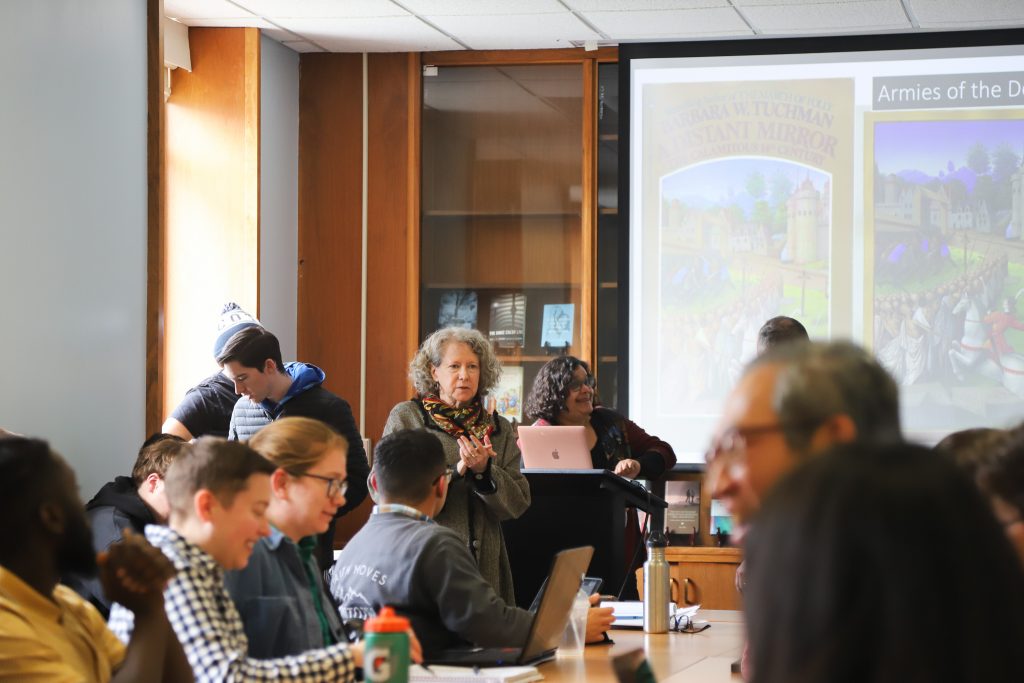The Center for Medieval and Renaissance Studies (CEMERS) hosted the first lecture in its 2024 Spring Speaker Series, which is centered around creating a new understanding of the Bubonic Plague.
Titled “Hidden Plagues: Rediscovering the History of Plague during Times of Famine,” the lecture was held on March 20 in the Institute for Advanced Studies in the Humanities Conference Room. This year’s speaker series is connected to a graduate course, “Cultural Responses to the Black Death,” led by Marilynn Desmond, a distinguished professor of English. The lecture focused on several important technological advances, particularly DNA analysis.
From March 20 to April 17 this year, CEMERS plans to host four public lectures on the Bubonic Plague — the bacterial disease that caused a pandemic in the 1330s. Co-sponsored by the history department and CEMERS, the series is intended to inform the campus community about the plague’s epidemiology and history, according to Desmond, who said she expected a diverse audience to attend the public lecture.
This lecture’s speaker, independent scholar Monica Green, began by discussing her publications on the Bubonic Plague’s transmission, which examined locations throughout the Eurasian landmass, the Indian subcontinent and Africa. Green believes that the Mongols were largely responsible for spreading the plague when they looked for sources of food, fur and leather from marmots — one of the largest rodents in the world and a creature they were familiar with in Mongolia.
“When they move out of Mongolia into what is now China [and] Kyrgyzstan, they’re finding new species of marmots,” Green said. “They think ‘oh marmots, we know how to hunt marmots, we know how to skin marmots, we know how to eat marmots, let’s collect marmots.’ But these marmots carry plague. That’s essentially what I think is happening then. So, they’ve disrupted the environments of these marmots. There may be a few outbreaks among the Mongols themselves.”
Green supported her theory by explaining that the obstruction of marmots’ habitats was responsible for spreading the Bubonic Plague — the fleas who lived off marmots traveled downhill into foothills where other rodents live. They then migrated to different host animals, who would gather in areas where humans cultivated grain. Green emphasized the importance of understanding how different disciplines intersect when considering these questions.
“I think we need to talk about [and] we need to consider the question of the prodromal stage of the pandemic that we normally call the Black Death,” Green said. “We need to take a look at these 13th and 14th century famines, which seem to be closely allied with episodes of pestilence, and we need to look at the perspectives on persecutions.”
The lecture concluded with a Q&A session, where Green emphasized that although there has been excellent academic analysis of the Mongol Empire, the historiography has largely avoided questioning the disease’s spread throughout their homeland.
Desmond said three more lectures on various topics surrounding the plague will be held later in the semester. Kenny Roggenkamp, a doctoral candidate in the department of English, will present “Revelation in a Time of Death: Julian of Norwich’s Shewings in a Pandemic Context” at 3 p.m. on March 27.
James Giallella, a freshman majoring in history, said attending the lecture expanded his understanding of the historical context surrounding the Bubonic Plague.
“I always thought of [the] Black Death as like a one-time thing,” Giallella said. “Learning more about globalizing history and introducing more perspectives that we commonly may not have had, helps us better as historians and people when we try to apply history to today, and I found it very informative. [Green] was a great speaker, and I hope that I’ll get to see her talk again sometime.”



